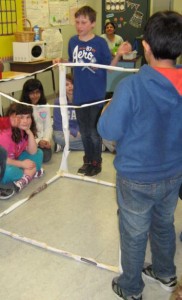Good evening!
We started our morning with our Monthly Virtues Assembly. This month our virtue is wonder. That actually fits into our classroom very easily, as we already look at a “Wonder of the Day” each day with http://wonderopolis.org/ each morning. We then answer the “Wonder of the Day” in the afternoon after lunch. I really enjoy the videos and we have a lot of fun taking the quizzes. Today’s “Wonder of the Day” was, “Why is it easier to lift someone in water than on land?” This afternoon we answered the question with some information about buoyancy and Archemides! Congratulations to everyone who was awarded a monthly award – keep up the good work!
In Math today we were able to finish building our cubic meter. Take a look at the image below. We then tried to estimate approximately how many cubic meters we thought the volume of our classroom would be. We had lots of great predictions. I heard students talking about how many cubes it would take to get to the ceiling, comparing the size of the cube to the ceiling tiles to help with estimating, and looking at the walls and the space of our classroom. More on measurement tomorrow!
In Science today we began discussing the 3 states of matter. We discussed solids, liquids, and gasses. Solids have particles that are tightly packed. They have strong attractive forces holding them together, and they only move a little; more like a vibration. Liquids have particles that are able to move. They slip and slide over one another easily. They have weaker attractive forces holding them together. This is why they don’t have a definite shape. Instead, they take the shape of their container. Gasses move a lot. We describe the particles as being very energetic. They move quickly and often bump into other particles. They have weak attractive forces holding them together, so they also take the shape of their container. Gasses will fill the entire container! We also talked about some of the changes that occur from one state of matter to another. For example, if a solid moves to a liquid, energy must have been added. If a liquid changes back into a solid, energy must have been removed. This can be done through things such as adding or taking away heat energy (eg. boiling water changes it into a gas). Finally, we discussed mixtures. Today we focused on heterogeneous mixtures. We discussed how the particles are not evenly mixed, and often you can still see the individual parts of the mixture. Think of a bucket of legos or a salad you would eat for lunch. A mechanical mixture is when you can see each separate component of the mixture. This also means that you could mechanically separate the mixture. You could sort your lego, or take the tomatoes out of your salad. Today we worked with 2 different heterogeneous mixtures. The first was sand and beads. Students were challenged to separate these two materials. They used a sieve. Students were given paper plates. They had to alter the plates so that the holes were large enough to allow the sand to pass through and small enough that the beads did not. We discovered that the sieve works quickly and efficiently if you make your holes as large as possible for the given materials, and with more holes in place. Students then worked with a mixture of sand, beads, and paper clips. They were allowed to use a magnet to aid them in separating these materials. Later we will continue our discussion of mixtures of solids, and we will be using air and water to help us to separate solids.
Agenda:
Read 20 minutes
Reading Journal – Friday
Book Orders – April 30th
Mathletics Meet-up: Wednesday @ 5:30 and 7:00 pm
Math: pgs. 143-144 #1-5, 7, 8
Unit Test – Friday
Science: Switch Projects – April 25th
L.A. – Bridge to Terabithia Character Maps (Wednesday)
Health – Girls Inc. Forms signed

